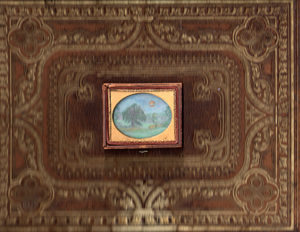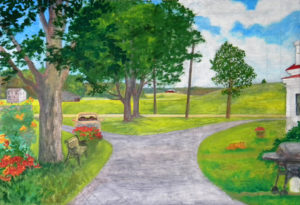“But here is an artist. He desires to paint you the dreamiest, shadiest, quietest, most enchanting bit of romantic landscape in all the valley of the Saco.”
 Down the Intervale #3 • oil on linen canvas-board 9” x 24” • collection of Audrey & Stephen Terry
Down the Intervale #3 • oil on linen canvas-board 9” x 24” • collection of Audrey & Stephen Terry
quote by Herman Melville (1819 – 1891) from chapter 1 – Loomings – of Melville’s masterpiece Moby Dick. When I read that descriptive passage in late August 2012 while visiting my brother Wallace and his family in Alaska, I intuitively felt that Melville had presciently described some of my future artistic aspirations, a century before I was born. I grew up less than a quarter mile from the river he refers to, which makes me curious as to which part “in all the valley of the Saco” he was familiar with, and how he came to know it, considering that he grew up in NYC and Albany, NY. Despite how many miles long the valley of the Saco is as it comes out of the White Mountains of New Hampshire, crosses the border into Maine and snakes its way to the Atlantic Ocean through York County, the southernmost of Maine’s counties, I like to think that Melville just might have known someone in the area whom he visited, and coincidentally trod some of the same intervale ground that I trod as a child. Admittedly, there’s little chance of that being true, but I still enjoy thinking about the possibility.
*intervale: a regional term defining a tract of low-lying land, especially along a river.
 Down the Intervale #8 & #10 • free-hand pencil drawings on either side of a single pine board 12” x 48”. An attempt to capture the same view of the Saco River Intervale, from the exact same spot at the back of my family’s barn. Since the two drawings are on either side of the same board, I was unable to compare how different their proportions were until I was back in Philadelphia, able to download photos then compare them by using photoshop. It was an interesting reminder of how inaccurately the eye interprets the scene in front of it when attempting to duplicate it through drawing or painting. A year or two later I colorized the top version, which I’ll feature when we get to it in chronological sequence.
Down the Intervale #8 & #10 • free-hand pencil drawings on either side of a single pine board 12” x 48”. An attempt to capture the same view of the Saco River Intervale, from the exact same spot at the back of my family’s barn. Since the two drawings are on either side of the same board, I was unable to compare how different their proportions were until I was back in Philadelphia, able to download photos then compare them by using photoshop. It was an interesting reminder of how inaccurately the eye interprets the scene in front of it when attempting to duplicate it through drawing or painting. A year or two later I colorized the top version, which I’ll feature when we get to it in chronological sequence.
 Down the Intervale #7 aka It’s Buttercup and Daffodil Season • oil on masonite panel, framed with antique window sash 30” x 25”
Down the Intervale #7 aka It’s Buttercup and Daffodil Season • oil on masonite panel, framed with antique window sash 30” x 25”
Painted in May of 2011 while house-sitting for two weeks in Dayton, Maine at the family farm where I had grown up. My oldest brother Clark, who had inherited the property, was in California with his wife visiting their daughter. It was the first time in a long time that I had the run of the place all to myself, which was totally enchanting as well as creatively inspiring. The season was spring, that wonderful time of annual transformation when the landscape trades its gown of subdued colors – the perennial deep-greens of the conifers, plus the browns and muted purples of fallow earth plus deciduous tree trunks and bare branches – for the emerging bud colors of spring. It’s like fall in miniature – tiny reds, oranges and yellows – that precede the all-transforming myriad of various greens in the trees, as well as the fields, by May mid-month. This particular view of landscape, which has seen many variations in my painted oeuvre over the years, is an artistically-condensed view seen from the back of the barn looking east toward the Saco River, hidden behind trees in the distance. The daffodils picked from the spring-flower gardens at the front of the barn were a complementary addition to the composition as a loosely-defined bouquet in a cobalt blue bottle that originally contained medicine, probably Pepto-Bismol. The fields themselves were profusely carpeted with fresh buttercups. What a delight! truly my favorite time of year in the country; or just about anywhere for that matter…
 Down the Intervale #12 • oil on illustration board, framed in half of an antique case that originally included a cover and held an early portrait photograph on glass of an unidentified individual, ca. 3” x 4”. The antique frame is mounted on an antique gold-stamped leather book-cover 9” x 12″ that was possibly part of a Bible at one point. You can see the outlines of where a clasp once was, the gold-stamping being much more vivid there • collection of Arthur Ostroff
Down the Intervale #12 • oil on illustration board, framed in half of an antique case that originally included a cover and held an early portrait photograph on glass of an unidentified individual, ca. 3” x 4”. The antique frame is mounted on an antique gold-stamped leather book-cover 9” x 12″ that was possibly part of a Bible at one point. You can see the outlines of where a clasp once was, the gold-stamping being much more vivid there • collection of Arthur Ostroff
 Dooryard – Looking West • oil on plywood panel 22.5” x 32” This is the view from the front of the barn at 588 River Road in Dayton, Maine where I grew up. The barn was like a second home to me as a child; one of my major playgrounds and places of learning as I explored every nook and cranny of its expanse. The structure is about seventy-two feet long by forty feet wide, and over thirty feel tall at its peak. It truly was a place of magic for me growing up. Over the years when I’ve been questioned “So did you grow up in a barn, or what?” I truthfully have to answer “Yes, I did! and proud of it, for the sense of stability and reality it gave me”
Dooryard – Looking West • oil on plywood panel 22.5” x 32” This is the view from the front of the barn at 588 River Road in Dayton, Maine where I grew up. The barn was like a second home to me as a child; one of my major playgrounds and places of learning as I explored every nook and cranny of its expanse. The structure is about seventy-two feet long by forty feet wide, and over thirty feel tall at its peak. It truly was a place of magic for me growing up. Over the years when I’ve been questioned “So did you grow up in a barn, or what?” I truthfully have to answer “Yes, I did! and proud of it, for the sense of stability and reality it gave me”
 Center City Philadelphia #3 • oil on wood panel, the bottom of a found-and-repurposed antique-bureau drawer measuring 17” x 12” x 2”
Center City Philadelphia #3 • oil on wood panel, the bottom of a found-and-repurposed antique-bureau drawer measuring 17” x 12” x 2”
This is only the third of a series of paintings started in 2010 depicting the view as seen from my 3rd floor studio looking north to the skyscrapers of Center City about two miles away. The view continues to evolve, as new high rises are added to the skyline. At the time of this series, there were only four major ‘scrapers on the horizon – the ones I refer to as the Obelisk, the Needles, and the Monolith. But the buildings are secondary; the sky is the focus of this painting which is my tribute to one of the greatest of the cloud-scape painters, Jacob van Ruisdael (1628 – 1682) the great Dutch landscapist.
 Center City Philadelphia #4 & #6: Night & Day • oil on unprimed wood panels. Painted on the bottoms of matching drawers 17” x 7” x 6” deep, which were originally part of the same street-found antique bureau that provided the wider, shallow drawer used as the basis for the above cloud-scape over the city. Totally missing from the trashed street-find were its four large bottom drawers, plus a matching companion to the shallow drawer of the above piece. All three surviving drawers were from the top section of a late 19th century mahogany-veneered bureau that must been very elegant in its day. Only the bureau’s frame, plus these three repurposed drawers, were salvageable. As usable furniture, the bureau was definitely questionable, since it was in bad, sad, beaten-up shape. But it proved utilitarian anyway; down in the basement as a divider/organizer, lying on its side, useful even without its drawers.
Center City Philadelphia #4 & #6: Night & Day • oil on unprimed wood panels. Painted on the bottoms of matching drawers 17” x 7” x 6” deep, which were originally part of the same street-found antique bureau that provided the wider, shallow drawer used as the basis for the above cloud-scape over the city. Totally missing from the trashed street-find were its four large bottom drawers, plus a matching companion to the shallow drawer of the above piece. All three surviving drawers were from the top section of a late 19th century mahogany-veneered bureau that must been very elegant in its day. Only the bureau’s frame, plus these three repurposed drawers, were salvageable. As usable furniture, the bureau was definitely questionable, since it was in bad, sad, beaten-up shape. But it proved utilitarian anyway; down in the basement as a divider/organizer, lying on its side, useful even without its drawers.
 2011: Center City Philadelphia #5: Sunrise • oil on found piece of wood 14.5” x 5.5” • collection of Heinz & Diane Sauk-Schubert
2011: Center City Philadelphia #5: Sunrise • oil on found piece of wood 14.5” x 5.5” • collection of Heinz & Diane Sauk-Schubert
I purposely left unpainted a magnificent Eye in the Skye – a bore or knot where a major limb had grown out from the central trunk. To make that natural beauty disappear under paint seemed a virtual sacrilege, so I didn’t. I was on a roll that year painting directly onto natural wood, unprimed, using the natural color of the wood as an element in the emerging coloration, as well as the overall composition.



{ 0 comments… add one now }